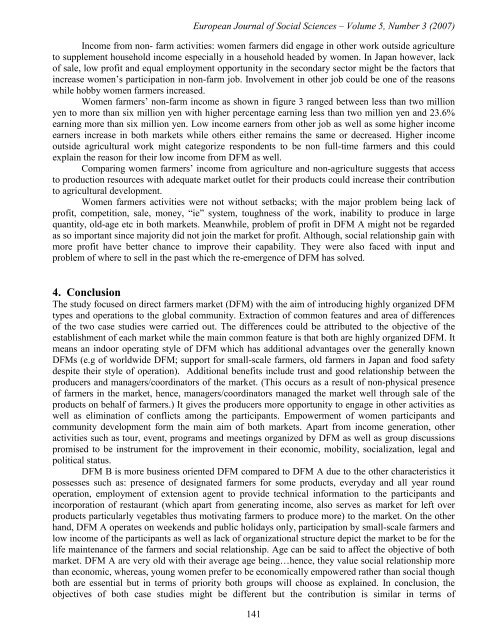european journal of social sciences issn: 1450-2267 - EuroJournals
european journal of social sciences issn: 1450-2267 - EuroJournals
european journal of social sciences issn: 1450-2267 - EuroJournals
You also want an ePaper? Increase the reach of your titles
YUMPU automatically turns print PDFs into web optimized ePapers that Google loves.
European Journal <strong>of</strong> Social Sciences – Volume 5, Number 3 (2007)<br />
Income from non- farm activities: women farmers did engage in other work outside agriculture<br />
to supplement household income especially in a household headed by women. In Japan however, lack<br />
<strong>of</strong> sale, low pr<strong>of</strong>it and equal employment opportunity in the secondary sector might be the factors that<br />
increase women’s participation in non-farm job. Involvement in other job could be one <strong>of</strong> the reasons<br />
while hobby women farmers increased.<br />
Women farmers’ non-farm income as shown in figure 3 ranged between less than two million<br />
yen to more than six million yen with higher percentage earning less than two million yen and 23.6%<br />
earning more than six million yen. Low income earners from other job as well as some higher income<br />
earners increase in both markets while others either remains the same or decreased. Higher income<br />
outside agricultural work might categorize respondents to be non full-time farmers and this could<br />
explain the reason for their low income from DFM as well.<br />
Comparing women farmers’ income from agriculture and non-agriculture suggests that access<br />
to production resources with adequate market outlet for their products could increase their contribution<br />
to agricultural development.<br />
Women farmers activities were not without setbacks; with the major problem being lack <strong>of</strong><br />
pr<strong>of</strong>it, competition, sale, money, “ie” system, toughness <strong>of</strong> the work, inability to produce in large<br />
quantity, old-age etc in both markets. Meanwhile, problem <strong>of</strong> pr<strong>of</strong>it in DFM A might not be regarded<br />
as so important since majority did not join the market for pr<strong>of</strong>it. Although, <strong>social</strong> relationship gain with<br />
more pr<strong>of</strong>it have better chance to improve their capability. They were also faced with input and<br />
problem <strong>of</strong> where to sell in the past which the re-emergence <strong>of</strong> DFM has solved.<br />
4. Conclusion<br />
The study focused on direct farmers market (DFM) with the aim <strong>of</strong> introducing highly organized DFM<br />
types and operations to the global community. Extraction <strong>of</strong> common features and area <strong>of</strong> differences<br />
<strong>of</strong> the two case studies were carried out. The differences could be attributed to the objective <strong>of</strong> the<br />
establishment <strong>of</strong> each market while the main common feature is that both are highly organized DFM. It<br />
means an indoor operating style <strong>of</strong> DFM which has additional advantages over the generally known<br />
DFMs (e.g <strong>of</strong> worldwide DFM; support for small-scale farmers, old farmers in Japan and food safety<br />
despite their style <strong>of</strong> operation). Additional benefits include trust and good relationship between the<br />
producers and managers/coordinators <strong>of</strong> the market. (This occurs as a result <strong>of</strong> non-physical presence<br />
<strong>of</strong> farmers in the market, hence, managers/coordinators managed the market well through sale <strong>of</strong> the<br />
products on behalf <strong>of</strong> farmers.) It gives the producers more opportunity to engage in other activities as<br />
well as elimination <strong>of</strong> conflicts among the participants. Empowerment <strong>of</strong> women participants and<br />
community development form the main aim <strong>of</strong> both markets. Apart from income generation, other<br />
activities such as tour, event, programs and meetings organized by DFM as well as group discussions<br />
promised to be instrument for the improvement in their economic, mobility, <strong>social</strong>ization, legal and<br />
political status.<br />
DFM B is more business oriented DFM compared to DFM A due to the other characteristics it<br />
possesses such as: presence <strong>of</strong> designated farmers for some products, everyday and all year round<br />
operation, employment <strong>of</strong> extension agent to provide technical information to the participants and<br />
incorporation <strong>of</strong> restaurant (which apart from generating income, also serves as market for left over<br />
products particularly vegetables thus motivating farmers to produce more) to the market. On the other<br />
hand, DFM A operates on weekends and public holidays only, participation by small-scale farmers and<br />
low income <strong>of</strong> the participants as well as lack <strong>of</strong> organizational structure depict the market to be for the<br />
life maintenance <strong>of</strong> the farmers and <strong>social</strong> relationship. Age can be said to affect the objective <strong>of</strong> both<br />
market. DFM A are very old with their average age being…hence, they value <strong>social</strong> relationship more<br />
than economic, whereas, young women prefer to be economically empowered rather than <strong>social</strong> though<br />
both are essential but in terms <strong>of</strong> priority both groups will choose as explained. In conclusion, the<br />
objectives <strong>of</strong> both case studies might be different but the contribution is similar in terms <strong>of</strong><br />
141

















